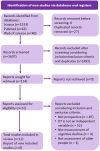Dual-Task Gait as a Predictive Tool for Cognitive Impairment in Older Adults: A Systematic Review
- PMID: 35002676
- PMCID: PMC8740025
- DOI: 10.3389/fnagi.2021.769462
Dual-Task Gait as a Predictive Tool for Cognitive Impairment in Older Adults: A Systematic Review
Abstract
The use of the dual-task model as a cognitive-motor interface has been extensively investigated in cross-sectional studies as a training task in cognitive impairment. However, few existing longitudinal studies prove the usefulness of this tool as a clinical marker of cognitive impairment in older people. What is the evidence in prospective studies about dual-task gait as a predictor of cognitive impairment in older adults? This study aims to review and discuss the current state of knowledge in prospective studies on the use of dual-task gait as a predictive tool for cognitive impairment in older adults. The methodology used was a systematic review, according to the PRISMA criteria for the search, summarize and report. A search in 3 databases (Pubmed, Web of Science, and Scopus) was carried out until April 2021. The search terms used were: "(gait OR walking) AND (cognitive decline) AND (dual-task) AND (follow-up OR longitudinal OR long-term OR prospective OR cohort OR predict)." We included prospective research articles with older people with cognitive evaluation at the beginning and the end of the follow-up and dual-task gait paradigm as initial evaluation associated with the presentation of cognitive impairment prediction using any dual-task gait parameters. After exclusion criteria, 12 studies were reviewed. The results indicate that eight studies consider dual-task gait parameters a useful cognitive-motor tool, finding that some of the evaluated parameters of dual-task gait significantly correlate with cognitive impairment over time. The most promising DT parameters associated with cognitive impairment prediction seem to be gait speed, speed cost, DT time, numbers of words during DT, among others. In sum, this study reviews the variety of dual-task gait parameters and their relevance as a simple tool for early cognitive impairment screening, opening a diagnostic window for the screening of cognitive impairment in older people.
Keywords: aging; cognitive decline; cognitive-motor task; dementia; screening tool.
Copyright © 2021 Ramírez and Gutiérrez.
Conflict of interest statement
The authors declare that the research was conducted in the absence of any commercial or financial relationships that could be construed as a potential conflict of interest.
Figures


Similar articles
-
A novel dual-task paradigm with story recall shows significant differences in the gait kinematics in older adults with cognitive impairment: A cross-sectional study.Front Aging Neurosci. 2022 Dec 15;14:992873. doi: 10.3389/fnagi.2022.992873. eCollection 2022. Front Aging Neurosci. 2022. PMID: 36589542 Free PMC article.
-
A taxonomy of cognitive tasks to evaluate cognitive-motor interference on spatiotemoporal gait parameters in older people: a systematic review and meta-analysis.Eur Rev Aging Phys Act. 2019 Jul 27;16:12. doi: 10.1186/s11556-019-0218-1. eCollection 2019. Eur Rev Aging Phys Act. 2019. PMID: 31372186 Free PMC article.
-
Dual task walking costs in older adults with mild cognitive impairment: a systematic review and meta-analysis.Aging Ment Health. 2021 Sep;25(9):1618-1629. doi: 10.1080/13607863.2020.1802576. Epub 2020 Aug 6. Aging Ment Health. 2021. PMID: 32757759
-
Age-related and dual task-induced gait alterations and asymmetry: optimizing the Semmelweis Study gait assessment protocol.Geroscience. 2025 Jun 6. doi: 10.1007/s11357-025-01722-6. Online ahead of print. Geroscience. 2025. PMID: 40478431
-
The Effects of Dual-Task Training on Cognitive and Physical Functions in Older Adults with Cognitive Impairment; A Systematic Review and Meta-Analysis.J Prev Alzheimers Dis. 2022;9(2):359-370. doi: 10.14283/jpad.2022.16. J Prev Alzheimers Dis. 2022. PMID: 35543010
Cited by
-
Dual-task turn velocity - a novel digital biomarker for mild cognitive impairment and dementia.Front Aging Neurosci. 2024 Feb 27;16:1304265. doi: 10.3389/fnagi.2024.1304265. eCollection 2024. Front Aging Neurosci. 2024. PMID: 38476660 Free PMC article.
-
Single and Dual Task Gait Speed in Frailty Screening of Community-Dwelling Older Adults.J Prim Care Community Health. 2024 Jan-Dec;15:21501319241306700. doi: 10.1177/21501319241306700. J Prim Care Community Health. 2024. PMID: 39660674 Free PMC article.
-
Relationship Between Cognitive Abilities and Lower-Limb Movements: Can Analyzing Gait Parameters and Movements Help Detect Dementia? A Systematic Review.Sensors (Basel). 2025 Jan 29;25(3):813. doi: 10.3390/s25030813. Sensors (Basel). 2025. PMID: 39943452 Free PMC article.
-
Pilates and Cognitive Stimulation in Dual Task an Intervention Protocol to Improve Functional Abilities and Minimize the Rate of Age-Related Cognitive Decline in Postmenopausal Women.Int J Environ Res Public Health. 2022 Oct 16;19(20):13333. doi: 10.3390/ijerph192013333. Int J Environ Res Public Health. 2022. PMID: 36293914 Free PMC article.
-
Effects of aging on cognitive and brain inter-network integration patterns underlying usual and dual-task gait performance.Front Aging Neurosci. 2022 Sep 28;14:956744. doi: 10.3389/fnagi.2022.956744. eCollection 2022. Front Aging Neurosci. 2022. PMID: 36247996 Free PMC article.
References
-
- Åhman H. B., Cedervall Y., Kilander L., Giedraitis V., Berglund L., McKee K. J., et al. . (2020b). Dual-task tests discriminate between dementia, mild cognitive impairment, subjective cognitive impairment, and healthy controls – a cross-sectional cohort study. BMC Geriatrics 20:258. 10.1186/s12877-020-01645-1 - DOI - PMC - PubMed
Publication types
LinkOut - more resources
Full Text Sources
Miscellaneous

